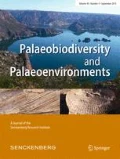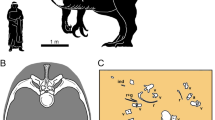Abstract
A disarticulated, though still roughly associated partial Deinotherium skeleton from the late Middle Miocene (late Sarmatian sensu stricto; 12.2–12.0 Ma) Gratkorn locality (Austria) is described. Based on dimensions and morphology of the material it can be determined as a medium-sized taxon of Deinotheriidae and definitively assigned to the genus Deinotherium. This specimen from Gratkorn confirms the osteological differences in the postcrania between Prodeinotherium and Deinotherium. As the diagnostically important p/3 is missing on the specimen it can only be assigned to Deinotherium levius vel giganteum. The Gratkorn specimen is one of not many skeletons of a medium-sized taxon of Deinotheriidae and one of only a few well-dated late Middle Miocene occurrences in Central Europe with associated dental and postcranial material.







Similar content being viewed by others
References
Aiglstorfer M, Bocherens H, Böhme M (2014) Large mammal ecology from the late Middle Miocene locality Gratkorn (Austria). In: Böhme M, Gross M, Prieto J (eds) The Sarmatian vertebrate locality Gratkorn, Styrian Basin. Palaeobio Palaeoenv 94(1). doi 10.1007/s12549-013-0145-5
Antoine PO (1994) Tendances évolutives de Deinotheriidae (Mammalia, Proboscidea) miocènes du domaine sous-pyrénéen. Master thesis. Université Paul-Sabatier, Toulouse
Bajgusheva SV, Titov V (2006) About teeth of Deinotherium giganteum Kaup from eastern paratethys. Hellenic J Geosci 41:177–182
Bergounioux F-M, Crouzel F (1962) Les déinothéridés d’Europe. Ann Paléontol 48:13–56
Böhme M, Aiglstorfer M, Uhl D, Kullmer O (2012) The antiquity of the Rhine river: stratigraphic coverage of the Dinotheriensande (Eppelsheim Formation) of the Mainz basin (Germany). PLoS ONE 7(5):e36817
Calandra I, Göhlich UB, Merceron G (2008) How could sympatric megaherbivores coexist? Example of niche partitioning within a proboscidean community from the Miocene of Europe. Naturwissenschaften 95(9):831–838. doi:10.1007/s00114-008-0391-y
Christiansen P (2004) Body size in proboscideans, with notes on elephant metabolism. Zool J Linn Soc 140(4):523–549. doi:10.1111/j.1096-3642.2004.00113.x
Christiansen P (2007) Long-bone geometry in columnar-limbed animals: allometry of the proboscidean appendicular skeleton. Zool J Linn Soc 149(3):423–436. doi:10.1111/j.1096-3642.2007.00249.x
Codrea V (1994) A priority issue: Deinotherium proavum Eichwald or Deinotherium gigantissimum Stefanescu? In: Petersen (ed) The Miocene from the Transylvanian Basin. Cluj-Napoca, Romania, pp 105–110
Conybeare A, Haynes G (1984) Observations on elephant mortality and bones in water holes. Quat Res 22(2):189–200. doi:10.1016/0033-5894(84)90039-5
Dehm R (1960) Zur Frage der Gleichaltrigkeit bei fossilen Säugerfaunen. Int J Earth Sci 49(1):36–40
Depéret C (1887) Recherches sur la succession des faunes des vertebres miocenes de la vallee du Rhone. Arch Mus Natl Hist Nat (Lyon) 4:45–313
Duranthon F, Antoine PO, Laffont D, Bilotte M (2007) Contemporanéité de Prodeinotherium et Deinotherium (Mammalia, Proboscidea) à Castelnau-Magnoac (Hautes Pyrénées, France). Rev Paléobiol 26(2):403–411
Éhik J (1930) Prodinotherium hungaricum n.g., n.sp. Institutum Regni Hungariae Geologicum 6:1–21
Fortelius M (2013) New and Old Worlds database of fossil mammals (NOW). University of Helsinki. Available at: http://www.helsinki.fi/science/now/. Accessed 2 Sept 2013
Galanti V, Preatoni D, Martinoli A, Wauters LA, Tosi G (2006) Space and habitat use of the African elephant in the Tarangire–Manyara ecosystem, Tanzania: Implications for conservation. Mamm Biol 71(2):99–114. doi:10.1016/j.mambio.2005.10.001
Gasparik M (1993) Deinotheres (Proboscidea, Mammalia) of Hungary. Ann Hist-Nat Mus Natl Hung 85:3–17
Gasparik M (2001) Neogene proboscidean remains from Hungary; an overview. Fragm Pal Hung 19:61–77
Ginsburg L, Chevrier F (2001) Les Dinothères du bassin de la Loire et l’évolution du genre Deinotherium en France. Symbioses 5:9–24
Göhlich UB (1998) Elephantoidea (Proboscidea, Mammalia) aus dem Mittel- und Obermiozan der oberen Süsswassermolasse Süddeutschlands: Odontologie und Osteologie. Münchner Geowiss Abh A 36:1–245
Göhlich UB (1999) Order Proboscidea. In: Rössner G, Heissig K (eds) The Miocene land mammals of Europe. Verlag Dr. Friedrich Pfeil, München, pp 157–168
Gräf IE (1957) Die Prinzipien der Artbestimmung bei Dinotherium. Palaeontogr Abt A Palaeozool-Stratigr 108(5/6):131–185
Gross M, Böhme M, Prieto J (2011) Gratkorn: A benchmark locality for the continental Sarmatian s.str. of the Central Paratethys. Int J Earth Sci (Geol Rundsch) 100(8):1895–1913. doi:10.1007/s00531-010-0615-1
Gross M, Böhme M, Havlik P, Aiglstorfer M, (2014) The late Middle Miocene (Sarmatian s.str.) fossil site Gratkorn - the first decade of research, geology, stratigraphy and vertebrate fauna. In: Böhme M, Gross M, Prieto J (eds) The Sarmatian vertebrate locality Gratkorn, Styrian Basin. Palaeobio Palaeoenv 94(1). doi:10.1007/s12549-013-0149-1
Harris JM (1973) Prodeinotherium from Gebel Zelten, Libya. Bull Br Mus (Nat Hist) Geol 23:285–350
Harris JM (1975) Evolution of feeding mechanisms in the family Deinotheriidae (Mammalia: Proboscidea). Zool J Linn Soc 56:331–362
Harris JM (1996) Isotopic changes in the diet of African Proboscideans. J Vertebr Paleontol 16(40A)
Havlik P, Aiglstorfer M, Beckman A, Gross M, Böhme M (2014) Taphonomical and ichnological considerations on the late Middle Miocene Gratkorn locality (Styria, Austria) with focus on large mammal taphonomy. In: Böhme M, Gross M, Prieto J (eds) The Sarmatian vertebrate locality Gratkorn, Styrian Basin. Palaeobio Palaeoenv 94(1). doi 10.1007/s12549-013-0142-8
Haynes G (1988) Longitudinal studies of african elephant death and bone deposits. J Archaeol Sci 15(2):131–157. doi:10.1016/0305-4403(88)90003-9
Hilber V (1914) Steirische Dinotherien. Mitt Naturwiss Ver Steiermark 51:111–132
Huttunen KJ (2000) Deinotheriidae (Probosidea, Mammalia) of the Miocene of Lower Austria, Burgenland and Czech Republic: Systematics, Odontology and Osteology. PhD thesis. Universität Wien, Vienna
Huttunen KJ (2002a) Systematics and Taxonomy of the European Deinotheriidae (Proboscidea, Mammalia). Ann Naturhist Mus Wien A 103A:237–250
Huttunen KJ (2002b) Deinotheriidae (Proboscidea, Mammalia) dental remains from the Miocene of Lower Austria and Burgenland. Ann Naturhist Mus Wien A 103A:251–285
Huttunen KJ (2004) On a Prodeinotherium bavaricum (Proboscidea, Mammalia) skeleton from Franzensbad, Czech Republic. Ann Naturhist Mus Wien A 105A:333–361
Huttunen KJ, Göhlich UB (2002) A partial skeleton of Prodeinotherium bavaricum (Proboscidea, Mammalia) from the Middle Miocene of Unterzolling (Upper Freshwater Molasse, Germany). Geobios 35:489–514
Joger U (2010) The way of life and ecology of modern elephants: Are conclusions about straight-tusked elephants and their habitat possible? [in German]. In: Meller H (ed) Elefantenreich. Eine Fossilwelt in Europa. Landesamt für Denkmalpflege und Archäologie Sachsen-Anhalt. Landesmuseum für Vorgeschichte, Halle, pp 314–321
Kaup JJ (1829) Neues Säugethier, Deinotherium: Deinotherium giganteum. Isis 22(4):401–404
Kaup JJ (1832) Description d’ossements fossiles de Mammifères inconnus jusquá present, qui se trouvent au Muséum grand ducal de Darmstadt. C. Stahl, Darmstadt
Kovachev D, Nikolov I (2006) Deinotherium thraceiensis sp. nov. from the Miocene near Ezerovo, Plovdiv District. Geol Balc 35(3–4):5–40
Lister AM (2013) The role of behaviour in adaptive morphological evolution of African proboscideans. Nature 500:331–334. doi:10.1038/nature12275
Markov GN (2008a) Fossil proboscideans (Mammalia) from the vicinities of Varna: a rare indication of middle Miocene vertebrate fauna in Bulgaria. Hist Nat Bulg 19:137–152
Markov GN (2008b) The Turolian proboscideans (Mammalia) of Europe: preliminary observations. Hist Nat Bulg 19:153–178
McComb K, Baker L, Moss C (2006) African elephants show high levels of interest in the skulls and ivory of their own species. Biol Lett 2(1):26–28. doi:10.1098/rsbl.2005.0400
Merceron G, Costeur L, Maridet O, Ramdarshan A, Göhlich UB (2012) Multi-proxy approach detects heterogeneous habitats for primates during the Miocene climatic optimum in Central Europe. J Hum Evol 63(1):150–161. doi:10.1016/j.jhevol.2012.04.006
Mottl M (1969) Die Säugetierfunde von St. Oswald bei Gratwein, westlich von Graz in der Steiermark. Festschrift des Landesmuseums Joanneum Graz:299-320
Mottl M (1970) Die jungtertiären Säugetierfaunen der Steiermark, Südost-Österreichs. Mitt Mus Bergbau Geol Tech 31:3–92
Musil R (1997) A Dinotherium Skeleton from Česká Třebová. Acta Mus Moraviae Sci Geol 82:105–122
Peters KF (1871) Über Reste von Dinotherium aus der obersten Miozänstufe der südlichen Steiermark. Mitt Naturwiss Ver Steiermark 2:367–399
Pickford M, Pourabrishami Z (2013) Deciphering Dinotheriensande deinotheriid diversity. Palaeobio Palaeoenv 93(2):121–150. doi:10.1007/s12549-013-0115-y
Poole JH (1996) The African elephant. In: Kangwana K (ed) Studying elephants. African Wildlife Foundation Technical Handbook Series vol 7. African Wildlife Foundation, Nairobi, pp 1–8
Stefanescu G (1894) Dinotherium gigantissimum. Annu Mus Geologia Paleontol 1894:126–199
Svistun VI (1974) Dinotheriums of Ukraine [in Russian]. Naukovka dumka, Kiev
Tarabukin BA (1968) Excavation of a deinothere skeleton in the Rezesh-Area of the Moldavian Republic [in Russian]. Proc Acad Sci Mold SSR, Biol Chem Sci 3:37–42
Tassy P (1996) Dental homologies and nomenclature in the Proboscidea. In: Shoshani J, Tassy P (eds) The Proboscidea—Evolution and palaeoecology of elephants and their relatives. Oxford University Press, Oxford, pp 21–25
Thenius E (1948) Über die Entwicklung des Hornzapfens von Miotragocerus. Oesterr Akad Wiss Math-Natwiss Kl Sitzungsber 157:203–221
Tobien H (1988) Contributions a l’étude du gisement miocène supérieur de Montredon (Herault). Les grands Mammifères. 7—Les proboscidiens Deinotheriidae. Palaeovertebrata, Mémoire Extraordinaire 1988:135-175
Vendl M (1930) Die Geologie der Umgebung von Sopron II. Erdeszeti Kiserletek 32
Vergiev S, Markov GN (2010) A mandible of Deinotherium (Mammalia: Proboscidea) from Aksakovo near Varna, Northeast Bulgaria. Palaeodiversity 3:241–247
Zázvorka V (1940) Deinotherium levius Jourdan a jeho stratigrafický význam (in Czech and English). Acta Mus Nat Pragae IIB 7:191–214
Acknowledgements
The authors are indebted to P. Havlik (GPIT) for fruitful discussions and correction of the manuscript. G. Rössner (SNSB-BSPG), G. Scharfe (IGM), R. Ziegler (SMNS), H. Lutz (NHMM), T. Engel (NHMM), H. Stapf (SSN), N. Spassov (NMNHS), G. Markov (NMNHS), L. Hristova (NMNHS), M. Ivanov (PMSU) and P. Havlik (GPIT) are thanked for the help and access to comparison material. D. Vasilyan (University Tübingen) is thanked for the help with the Russian literature. W. Gerber (University Tübingen) and A. Schumacher (NHMW) are thanked for taking pictures. N. Winkler (UMJGP) is thanked for preparation of the material. Many thanks go to the reviewers, G. Markov (NMNHS) and M. Pickford (MNHN), who greatly supported the improvement of the manuscript with their careful comments and correction of the English. For improvement of the English we want to thank as well A. Beckmann (University Tübingen). And last but not least the authors want to thank the students and volunteers from Graz, Munich and Tübingen for the good work in the excavations from 2005 to 2013.
Author information
Authors and Affiliations
Corresponding author
Additional information
This article is a contribution to the special issue “The Sarmatian vertebrate locality Gratkorn, Styrian Basin.”
Rights and permissions
About this article
Cite this article
Aiglstorfer, M., Göhlich, U.B., Böhme, M. et al. A partial skeleton of Deinotherium (Proboscidea, Mammalia) from the late Middle Miocene Gratkorn locality (Austria). Palaeobio Palaeoenv 94, 49–70 (2014). https://doi.org/10.1007/s12549-013-0140-x
Received:
Revised:
Accepted:
Published:
Issue Date:
DOI: https://doi.org/10.1007/s12549-013-0140-x




